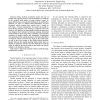Free Online Productivity Tools
i2Speak
i2Symbol
i2OCR
iTex2Img
iWeb2Print
iWeb2Shot
i2Type
iPdf2Split
iPdf2Merge
i2Bopomofo
i2Arabic
i2Style
i2Image
i2PDF
iLatex2Rtf
Sci2ools
ICRA
2005
IEEE
2005
IEEE
Design Considerations for Robotic Needle Steering
— Many medical procedures involve the use of needles, but targeting accuracy can be limited due to obstacles in the needle’s path, shifts in target position caused by tissue deformation, and undesired bending of the needle after insertion. In order to address these limitations, we have developed robotic systems that actively steer a needle in soft tissue. A bevel (asymmetric) tip causes the needle to bend during insertion, and steering is enhanced when the needle is very flexible. An experimental needle steering robot was designed that includes force/torque sensing, horizontal needle insertion, stereo image data acquisition, and controlled actuation of needle rotation and translation. Experiments were performed with a phantom tissue to determine the effects of insertion velocity and bevel tip angle on the needle path, as well as the forces acting on the needle during insertion. Results indicate that needle steering inside tissue does not depend on insertion velocity, but does depe...
| Added | 25 Jun 2010 |
| Updated | 25 Jun 2010 |
| Type | Conference |
| Year | 2005 |
| Where | ICRA |
| Authors | Robert J. Webster III, Jasenka Memisevic, Allison M. Okamura |
Comments (0)

